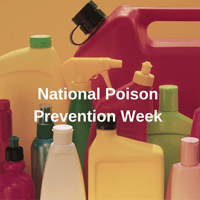National Poison Prevention Week
Written by Staff Writer

We are exposed to poisons and potentially hazardous chemicals both at work and at home, sometimes without even realizing any danger exists at all. Recognizing and understanding these hazards is the best way to keep yourself, your family, and your employees safe.
The third full week of each March is National Poison Prevention Week. This annual poison safety awareness event highlights the dangers of noxious substances and lifesaving solutions to common poison hazards
Acute Poisoning
According to the American Association of Poison Control Centers, every year, America's poison centers receive millions of calls, the majority of which are about people coming into contact with dangerous or potentially dangerous substances.
The good news is there are many steps you can take to work safely around potentially hazardous chemicals, which we will discuss shortly. However, if you ever have an emergency and need help right away, the Poison Help line is available at 1-800-222-1222. Or you can also visit PoisonHelp.org.
Standards and Solutions
Now that you have some tips for what to do in case of a serious emergency, addressing prevention is essential to everyone's safety both at work and at home. Luckily, Hazard Communication, also oftentimes referred to as HazCom, is based on the simple concept that employees have both a need and a right to know the hazards and identities of the chemicals they are exposed to while working.
The Hazard Communication Standard (HCS) is aligned with the Globally Harmonized System of Classification and Labeling of Chemicals (GHS). All American companies must comply with the most recent version of OSHA’s HCS, which adopts GHS standards for chemical safety documentation.
What’s in the HCS?
The Hazard Communication Standard Includes:
- Hazard classification: HCS provides specific criteria for classifying health and physical hazards of chemicals and mixtures.
- Labels: Chemical manufacturers and importers are required to provide labels for each compound that include a harmonized signal word, pictogram and hazard statement for each hazard class and category. Precautionary statements must also be provided.
- Safety Data Sheets: Using an approved 16-section format, manufacturers must supply detailed chemical data for each compound.
- Information and training: Employers are required to train workers on the elements of GHS labels and safety data sheets to facilitate recognition and understanding.
Both the OSHA HazCom standard and the GHS change from time to time. Check the OSHA website for the current version of these federal rules.
Poison Control Training
It's important to ensure that employees are up to date on the most recent version of the HCS. Workers should receive regular training regarding potentially hazardous chemicals in the workplace. Our GHS & Hazard Communication Online Course serves businesses who need an efficient, effective and affordable route for training employees in this subject area.
In addition, we also provide training for Crystalline Silica Awareness for employees who work around this hazardous material. For more information or to register for this course, please click here.
For more information on poison control centers and to locate your local center, please click here.
